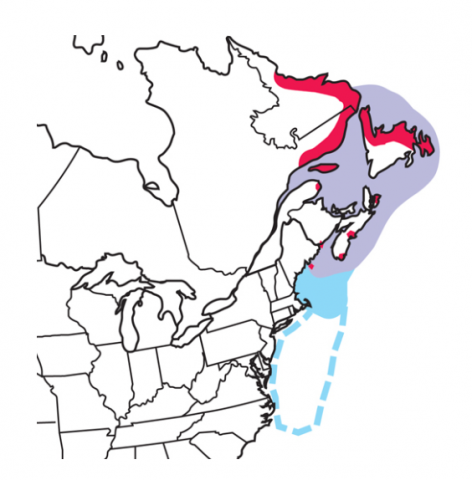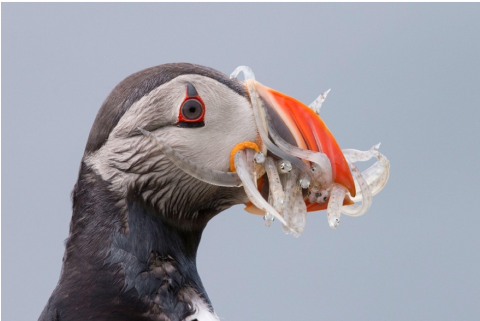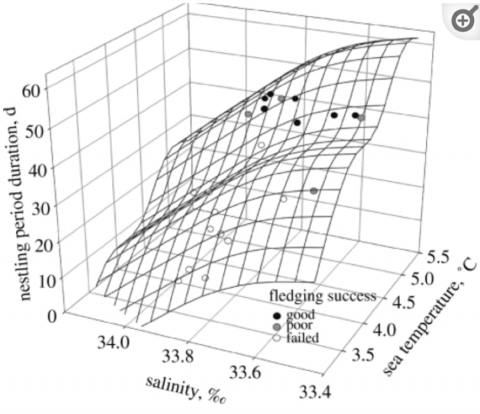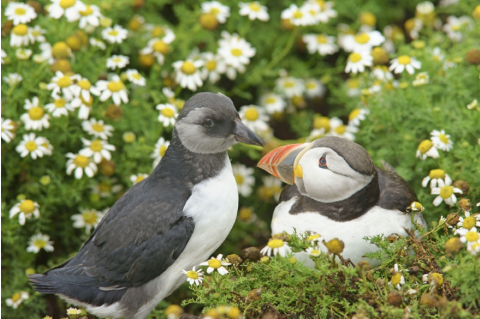Introduction
Similar to many animals in the world, the North Atlantic Puffin population are facing consequences of anthropogenic climate change (Audubon 2022); although, the first major decline in population is attributed to the overharvesting of eggs and adult birds (Audubon 2022). Unlike their prior population decline, todays change cannot be seen above the ocean surface, but rather what’s going on below. With the increase in anthropogenic emissions global oceans are seeing a continual increase in water temperature (IPCC 6th ASRP 2022, Saba et al. 2018) which is associated with water stratification (IPCC 6th ASRP 2022, Keeling and Visbeck, 2011), higher rates of harmful algal blooms (Chapra et al. 2017, Peperzak 2003) and more (IPCC 6th ASPRP 2022), which are creating hazards for the puffins as follows:
- Decrease in size (Hansen et al. 2021);
- Trophic food web changes causing a dietary change (Kress et al. 2017);
- Increase in travel for food (Fayet et al. 2021; Kress et al. 2017);
- Fledging period length and Fledging survival (Kress et al. 2016 ; Perrins, 1966); and
- Puffin productivity (Hansen et al. 2021; Durant and Stenseth, 2006).
Drivers of Ocean temperature change in the NW Atlantic Ocean (Risk)
The North Atlantic Puffin is particularly at risk of ocean temperature change as the regional temperature is expected to increase twice the rate of the global ocean under high emission scenarios (Saba et al. 2018). With global ocean temperature increase (IPCC 6th ASRP 2022) the American Meridional Overturning Circulation has begun to weaken (Caesar et al. 2018; Hasken et al. 2020; Jackson et al. 2020) resulting a cooling in the subpolar Atlantic Ocean (Caesar et al. 2018) but a net warming effect from the Gulf Stream (Caesar et al. 2018; Saba et al. 2015). The result causes an influx of warm waters from the Gulf Stream to circulate through the Northwest Atlantic Ocean causing a faster rate of temperature rise (Saba et al. 2015). Thus, the North Atlantic puffin are even more vulnerable to the effects of ocean temperature rise, unless the rate American Meridional Overturning Circulation strengthens once more. Although, this seems unlikely as global ocean temperature may have already reached a tipping point (IPCC 6th ASRP 2022; Heinze et al. 2021; Barnard et al. 2021; Lenton et al. 2008).
Increasing ocean temperature creates a more susceptible Puffin: A domino Effect (Hazard)
Domino #1: Trophic food web changes causes a diet change
Ocean temperature rise expresses a fluctuation in community structure, often resulting from an increase in primary productivity (Chapra et al. 2017; Feng et al. 2009). Which can cause a stable food web to destabilize, thus impacting apex predators such as puffins (Beaugrand, 2009). With the projected expansion of North Atlantic spring algae blooms (Gobler et al. 2017; Feng et al. 2009), further changes to the nutrient cycle (University of East Angilia, 2013) can be expected. Puffins are extremely capable hunters (Audubon, 2022) and are often recognized as good indicators of forage fish populations; through their extended chick-rearing period (Kress et al. 2017). And have expressed that ocean temperature has changed their diet (Saba et al. 2018) as the consumption of White Hake and Herring (primary food choice) have declined (Saba et al. 2018; NAFO, 2021). This decline is associated with a herring and White Hakes consumption of plankton (NAFO, 2022), who are abundant in colder waters (Bergstrom, 2016). Meaning that as water temperature increases, plankton populations decrease causing a decline white hake and herring populations within the warmer waters (Bergstrom, 2016). The increase in ocean temperature within the north Atlantic may further impact the type of food being consumed by puffins.
Domino #2: Food Change results in the increase in the travel for food:
The puffin food change is caused by both human induced ocean warming (Kress et al. 2017), but also through an increase in fishing pressure (NAFO, 2021). The effects of which have led to an increase in the consumption of butterfish, haddock, and redfish (Kress et al. 2017; Bergstrom, 2016), with respect to the decline in white hake and herring population decline (NAFO, 2022). In an effort to find food, the North Atlantic Puffin has been shown to travel farther and diving to deeper depths to find food (Fayet et al. 2021; Kress et al. 2017). It was found that puffins with greater foraging ranges have seen a decline in their population sizes (Fayet et al. 2021). Thus, as fishing pressure and ocean warming continue to decline fish populations, the correlating increase in puffin forage ranges leads to a decline in puffin population.
Domino #3: Lack of sufficient food for Puffin fledging’s leads to an increase in nesting time and a decrease in size
Puffin fledging (time it takes for a puffin to leave its nest, also referred to as its nesting period) typically takes between 34 and 60 days (RSPB 2022), although it is dependent on food availability, date of incubation, and year (RSPB 2022; Perrins 1966). Change in environmental conditions caused by climate change enables a higher probability that nutrition standards for fledging puffins are unmet (Durant et al. 2006). This leads to a decrease in puffin fledging size (Walker and Meijer, 2021; Kress et al. 2017; Durant et al. 2006; Gjerdrum et al. 2003), a decline in puffin reproduction (Audubon, 2022; Durant et al. 2006; Gjerdrum et al. 2003), and an increase in fledging period length ( Hansen et al. 2021; Durant et al. 2006; Barret et al. 1987). Each of these play a major role in the success rate of fledging puffins (Duran et al. 2006). The decrease in fledging size can be attributed to the lack of proper food available to them (Durant et al. 2006). Larger puffin fledglings are known to have higher success rates post nesting period (Stempneewicz and lliszko, 2002) than those of smaller stature (Durant et al. 2006; Stempneewicz and lliszko, 2002). Lack of size has also been correlated with nesting period length; smaller puffins are shown to spend more time in nests than larger fledglings (Hansen et al. 2021; Stempneewicz and lliszko, 2002) The effects of which also has an association with mortality (Stempneewicz and lliszko, 2002); longer nesting periods results in a higher mortality rates (Durant et al. 2006; Stempneewicz and lliszko, 2002). It has also been indicated that a decrease in available food can be attributed to puffin productivity (Kress et al. 2016); a decline in available food results in a decline in productivity, impacting population size. Thus, as climate change continues to increase ocean temperature the North Atlantic Puffin may be unable to obtain the necessary amount of food for their offspring leading to higher rates of mortality and an overall decrease in population (Kress et al. 2017; Durant et al. 2006; Barret et al. 1987).
Domino #4: Climate induced disturbance leads a decline in puffin productivity
Climate change is not only responsible for affecting global oceans (IPCC 6th ASRP 2022), but it also causes an increase in environmental disturbances (IPCC 6th ASRP 2022); which can be attributed to the breeding success of puffins (Audubon, 2022; Rodway et al. 1996). Environmental conditions are key indicators for the breeding performance of puffins (Major et al. 2021; Rodway et al. 1996), noting that an increase in temperature results in a general decrease in their productivity (Rodway et al. 1996). Ocean warming causes prey to grow slower or move northward toward cooler waters (Levke and Smith, 2005), causing puffins to become unable to obtain sufficient body weight to complete their breeding process (Major et al. 2021); causing either a delay in their breeding (Norris and Marra, 2007) or a failure to breed (Major et al. 2021). Which has led the North West Atlantic Puffin to shift their hatch date later (Major et al. 2021; Burthe et al. 2012), as a response to the lack of prey availability (Kress et al. 2016; Norris and Marra 2007); causing an overall reduction in hatch success (Major et al. 2021, Burthe et al. 2012). Thus, climate induced disturbances to both water and climate temperatures have caused a decline in puffin productivity, further contributing to a decline in their population size.
Conservation Efforts
The Audubon Society of America is a non profit organization that partakes in animal and land conservation around the United States. Through this organization "Project Puffin" is funded enabling the North West Atlantic Puffin to being protected as follows:
Goal: "To restore puffins to historic nesting sites in the Gulf of Maine"
-Island Protection: Eastern Egg Rock
-Jenny Island
-Matinicus Rock
-Outer Green Island
-Pond Island NWR
-Seal Island NWR
-Stratton Island
sources
insert sources here
Barnard, P.L., Dugan, J.E., Page, H.M., Wood, N.J., Hart, J.A., Cayan, D.R., Erikson, L.H., Hubbard, D.M., Myers, M.R., Melack, J.M., Iacobellis, S.F. (2021). Multiple climate change-driven tipping points for coastal systems. Scientific Reports, 11.
Barrett, R. T., Anker-Nilssen, T., Rikardsen, F., Valde, K., Røv, N., & Vader, W. (1987). The Food, Growth and Fledging Success of Norwegian Puffin Chicks Fratercula arctica in 1980-1983. Ornis Scandinavica (Scandinavian Journal of Ornithology), 18(2), 73–83.
Beauguard, G. (2009). Decadal changes in climate and ecosystems in the North Atlnatic Ocean and Adjacent Seas. Deep Sea Research Partt II: Tropical Studies in Oceanography, 56(8-10), 656-673.
Bergstrom, L. (2016) What a baby Puffin’s diet tells us about its future.
Burthe, S., Daunt, F., Butler, A., Elston, D.A., Frederiksen, M. Johns, D. Newell, M., Thackeray, S.J., Wanless, S. (2012). Phenological trends and trophic mismatch across multiple levels of a North Sea pelagic food web. Inter-Reseach Science Publisher, 119-133.
Caesar, L., Rahmstorf, S., Ribinson, O., Fuelner, G., Saba, V. (2018). Observed fingerprint of a weakening Atlantic Ocean overturing circulation. Nature, 556, 191-196).
Chapra, S.C., Boehlert, B., Fant, C., Bierman Jr, V.J., Henderson, J., Mills, D., Mas, D.M., Rennels, L., Jantarasami, L., Martinich, J., Strzepek, K.M., Paerl, H.W. (2017). Climate Change Impacts on Harmful Algal Blooms in U.S. Freshwaters: A Screening-Level Assessment. Environemntal Science and Technology, 51(16), 8933-8943.
Durant, J.M., Anker-Nilssen, T., Stenseth, N. C. (2006). Ocean Climate prior to breeing affects the duration of the nestling period in the Atlantic puffin. Biology Letters.
Fayet, A.L., Clucas, G.V., Anker-Nilssen, T., Syposz, M., Hansen, E.S. (2021). Local prey shpratges drive foraging costs and breeding success in a declining seabird, the Atlantic puffin. British Ecological Society, 90(5), 1152-1164.
Feng, Y., Hare, C.E., Lebanc, K., Rose, J.M., Zhang, Y., DiTullio, G.R., Lee, P.A., Wilhelm, Rowe, J. M., Sun, J., Nemecek, N., Gueguen\, C., Passow, U., Benner, I., Brown, C., Hutchins, D.A. (2009). Effects of increase pCO2 and temperature on the North Atlantic spring bloom. The phytoplankton community and biogeochemical response. Inter-Research Science Publisher, 388, 13-25.
Gjerdrum, C., Vallee, A.M.J., Clair, Blackburn, G.S. (2003). Tufted puffin reproduction reveals ocean climate variability. PNAS, 100(16) 9377-9382
Haskins, R.K., Oliver, K.I., Jackson, L.C., Wood, R.A., Drijfout, A.S. (2020). Tempertaure domination of AMOC weakening due to freshwater hosing in two GCms. Springer, 54, 273-286.
Hansen, E.S., Sandvik, H., Erikstad, K.E., Yoccoz, N.G., Anker-Nilssen, T. Bader, J. Descamps, S. Hodges, K. Mesquita, M.D.S., Reiertsen, T.K. Varpe, O. (2021). Centennial relationships between ocean temperature and Atlantic puffin production reveal shifting decennial trends. Global Change in Biology, 27(16), 3753-3763)
Heinze, C., Bleckner, T., Martins, H., Wilson, S. (2021). The quiet crossing of ocean tipping points. PNAS, 119(9).
Jackson, L.C., Roberts, M.J., Hewitt, H.T., Iovino, D., Koenigk, T., Meccia, V.L., ROberst, C.D., Robert, Y., Wood. (2020). Impact of ocean resolution and mean state on the rate of AMOC weakening. Springer link, 55, 1711-1732.
Keeling, R.F., Visbek, M. (2011). On the linkage between Antarctic surface water stratification and global deep water temperature. Journal of Climate, 24(11), 3545-3557.
Kress, W.S., Shannon, P., O’Neil, C. (2016). Recent changes in the diet and survival of Atlantic puffin chicks in the face of climate change and commercial fishing in midcoast Maine, USA. Facets.
Lenton, T.M., Held, H., Kriegler, E., Schellnbur, H.J. (2008). Tipping elements in the earth’s climate system. PNAS, 105(6), 1786-1793.
Levke and Smith: https://books.google.com/books?hl=en&lr=&id=tNDVs5lGvPcC&oi=fnd&pg=PA123&ots=fRQdy4f5up&sig=jKo5R9JAdFJVZx72SA2WrGyNykQ#v=onepage&q&f=false
Major, H.L., Durham, S.E., Fana, N., Rivers, J.E., Diamond, A.W. (2021). Contrasting phenological and demographic responses of Atlantic Puffin and Razorbill to climate change in the Gulf of Maine. Elementa, 9(1)
NAFO 2021: https://www.nafo.int/Portals/0/PDFs/sc/2021/scr21-022.pdf
Norris, D.R., & Marra, P.P. (2007) Seasonal interactions, habitat quality, and population dynamics in migratory birds. Ornithological Applications, 109(3), 535-547.
Peperzak, L. (2003). Climate change and harmful algal blooms in the North Sea. Acta Oecologica, 24(1), s139-s144.
Perrins, C.M.(1966) Survival of young man shearwaters puffinus puffinus in relation to their presumes date of hatching. Wiley Online Library, 108(1), 132-135.
Rodway, M.S., Montevecchi, W.A., Chardine, J.W. (1996). Effects of investigator disturbance on breeding success of Atlantic Puffins Fratercula artica. Biological Conservation, 76(3), 311-319.
Saba et al (2015). Enhanced warming of the Northwest Atlantic Ocean under climate change. Advancing Earth and Space Science, 121(1), 118-132.
Stempniewicz, L., & Iliszko, L. (2002). Body Size and Timing of Fledging of Atlantic Puffins in the Faeroes and Northwest Norway. Waterbirds: The International Journal of Waterbird Biology, 25(2), 164–172
University of East Angilia (2013). Climate change will upset vital ocean chemical cycles, research shows. Science Daily.
Walker, S.J., & Meijer H.J.M. (2021). Size variation in mid-Holocene North Atlantic Puffins indicates a dynamic response to climate change. Plos One,







